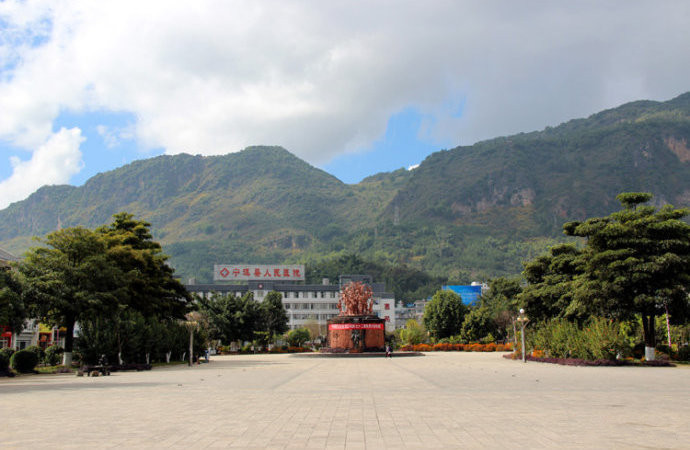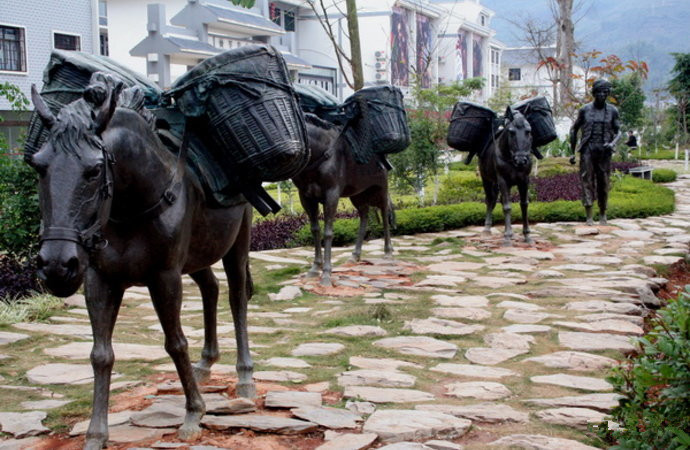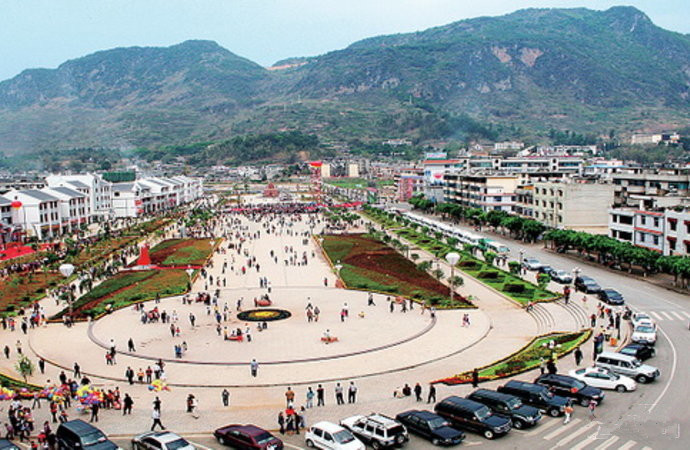
The Square of Tea Origin in Ninger County, Puer
Chinese Name:宁洱县茶源广场
English Name: The Square of Tea Origin in Ninger County, Puer
Cha Yuan Square was established in 2005 as a commemorative project for the 20th anniversary of the founding of Pu’er Hani and Yi Autonomous County (now Ning’er County). The square, which spans 82 acres, is the largest urban square in Pu’er City. It is centered around the culture of Pu’er tea and embodies the spirit of “Cultural Ning’er, Charming Tea Town, Pu’er Tea Capital.”
Qi Zi Bing Square
On the east side of the square is a small circular plaza known as “Qi Zi Bing Square” because it resembles the shape of a seven-pieces tea cake. This plaza features stone sculptures representing various forms of Pu’er tea, including cake tea, brick tea, square tea, tuo tea, and mushroom tea. Traditionally, Pu’er tea has been compressed for convenience in measurement, trade, and long-distance transportation.
“Tea’s Source, Road’s Beginning” Monument
To the left of the square is the permanent site of the Yunnan Pu’er Tea Association. In front of the association is the “Tea’s Source, Road’s Beginning” monument, also known as the “Tea Horse Road Zero Kilometer Monument.” It symbolizes the starting point of the Tea Horse Road, with the five renowned Tea Horse Roads extending from here and spreading Pu’er tea worldwide. This monument was established jointly by the Yunnan Provincial Department of Culture, the Yunnan Provincial Department of Transportation, and the Yunnan Tea Horse Road Research Association on April 9, 2006, the founding date of the Yunnan Pu’er Tea Association.
Tribute Tea Return Monument
The Tribute Tea Return Monument is located on the northern side of Cha Yuan Square. It measures 3.6 meters in both length and width and stands 4.6 meters tall, facing the Tea Horse Road Zero Kilometer Monument. It commemorates the return of the century-old tribute tea, “Wan Shou Long Tuan,” stored in the Palace Museum, to Ning’er in 2007.
Pu’er Prefecture City Map
In the 7th year of Yongzheng (1729 AD), Pu’er Prefecture built a city wall with bricks outside and earth inside, replacing the earlier earth wall. By the 18th year of Qianlong (1753 AD), the wall was rebuilt entirely with bricks. The ancient city included over 70 buildings such as official offices, temples, pavilions, guild halls, and educational institutions, and had four city gates: East Gate (“Chaoyang”), South Gate (“Huaiyuan”), West Gate (“Xuanwu”), and North Gate (“Gongji”). As a major economic, political, cultural, and military center in southern Yunnan, Pu’er Prefecture was bustling with merchants and activities. The city was likened to a large book, with Phoenix Mountain to the north resembling a phoenix spreading its wings. The ancient city also resembled a horse saddle, reflecting its deep connection with horse caravans and tea. Unfortunately, after liberation, the city walls fell into disrepair and were demolished in 1951 to make way for the Ring City Road. The grand Pu’er city walls had stood for 222 years. The back of the city map features the “Pu’er Prefecture Ode” written by Ning’er scholars.
Main Sculpture
The main sculpture in Cha Yuan Square is circular, symbolizing unity. The top of the sculpture features a flourishing ancient tea tree and tea-picking figures, representing the unity and prosperity of the various ethnic groups in Ning’er County. It also signifies that Ning’er is the birthplace of Pu’er tea and the origin of the Tea Horse Road. The circular sculpture is divided into four panels, depicting tea planting, processing, tasting, and tribute. It reflects how the people of Ning’er have lived in harmony with tea throughout history, using it to build friendships and make tributes. The horse heads in the sculpture symbolize Ning’er as the source of Pu’er tea, carrying hope to the world.

 7 Days GolfingTour
7 Days GolfingTour
 8 Days Group Tour
8 Days Group Tour
 8 Days Yunnan Tour
8 Days Yunnan Tour
 7 Days Shangri La Hiking
7 Days Shangri La Hiking
 11 Days Yunnan Tour
11 Days Yunnan Tour
 6 Days Yuanyang Terraces
6 Days Yuanyang Terraces
 11 Days Yunnan Tour
11 Days Yunnan Tour
 8 Days South Yunnan
8 Days South Yunnan
 7 Days Tea Tour
7 Days Tea Tour
 8 Days Muslim Tour
8 Days Muslim Tour
 12 Days Self-Driving
12 Days Self-Driving
 4 Days Haba Climbing
4 Days Haba Climbing
 Tiger Leaping Gorge
Tiger Leaping Gorge
 Stone Forest
Stone Forest
 Yunnan-Tibet
Yunnan-Tibet
 Hani Rice Terraces
Hani Rice Terraces
 Kunming
Kunming
 Lijiang
Lijiang
 Shangri-la
Shangri-la
 Dali
Dali
 XishuangBanna
XishuangBanna
 Honghe
Honghe
 Kunming
Kunming
 Lijiang
Lijiang
 Shangri-la
Shangri-la
 Yuanyang Rice Terraces
Yuanyang Rice Terraces
 Nujiang
Nujiang
 XishuangBanna
XishuangBanna
 Spring City Golf
Spring City Golf
 Snow Mountain Golf
Snow Mountain Golf
 Stone Mountain Golf
Stone Mountain Golf















